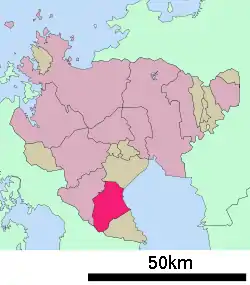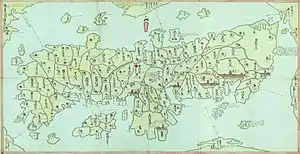Kashima Domain
Kashima Domain (鹿島藩, Kashima-han) was a Japanese domain of the Edo period. It is associated with Hizen Province in modern-day Saga Prefecture.[1]
| Kashima Domain 鹿島藩 | |
|---|---|
| Domain of Japan | |
| 1609–1871 | |
| Capital | Tsunehiro Castle (1609–1807) Kashima Castle (1807–1871) |
| • Type | Daimyō |
| Historical era | Edo period |
• Established | 1609 |
• Disestablished | 1871 |
| Today part of | Saga Prefecture |

In the han system, Kashima was a political and economic abstraction based on periodic cadastral surveys and projected agricultural yields.[2] In other words, the domain was defined in terms of kokudaka, not land area.[3] This was different from the feudalism of the West.
History
Kashima domain was originally a sub-domain of the Saga Domain, founded in 1610 for Nabeshima Tadashige, the younger brother of the first daimyō of Saga Domain, Nabeshima Katsushige. Tadashige already had holdings of 5000 koku in what is now part of Katori District, Chiba, so the additional 20,000 koku from his brother made his total revenues 25,000 koku. Tadashige’s son Nabeshima Masashige became second daimyō of Kashima; however, Masashige was dispossessed in 1642 when Kashima domain was given by Nabeshige Katsushige to his own 9th son, Nabeshima Naotomo. Masashige was allowed to keep his father’s original 5000 koku holdings, and was reduced to the status of hatamoto. Naotomo’s line continued to rule Kashima until the Meiji Restoration, and was subject to the same sankin-kōtai regulations as other domains. However, Kashima was not allowed to build a proper castle, but instead only had a fortified house (jin'ya). After the abolition of the han system in 1871, the former final daimyō, Nabeshima Naoyoshi became a viscount (shishaku) under the kazoku peerage, and Kashima domain was absorbed into the new Saga Prefecture.
List of daimyōs
The hereditary daimyōs were head of the clan and head of the domain.
- Nabeshima clan, 1635–1868 (tozama; 20,000 koku)[4]
Name Tenure Courtesy title Court Rank Revenue 1 Nabeshima Tadashige (鍋島忠茂) 1609–1624 Izumi-no-kami Lower 5th (従五位下) 25,000 koku 2 Nabeshima Masashige (鍋島正茂) 1624–1642 6th (従五位下) 25,000 koku 3 Nabeshima Naotomo (鍋島直朝) 1642–1672 Izumi-no-kami Lower 5th (従五位下) 20,000 koku 4 Nabeshima Naoeda (鍋島直條) 1672–1705 Bizen-no-kami Lower 5th (従五位下) 20,000 koku 5 Nabeshima Naokata (鍋島直堅) 1705–1727 Izumi-no-kami Lower 5th (従五位下) 20,000 koku 6 Nabeshima Naosato (鍋島直郷) 1728–1763 Bizen-no-kami Lower 5th (従五位下) 20,000 koku 7 Nabeshima Naohiro (鍋島直熙) 1763–1770 Izumi-no-kami Lower 5th (従五位下) 20,000 koku 8 Nabeshima Naoyoshi (鍋島直宜) 1770–1801 Bizen-no-kami Lower 5th (従五位下) 20,000 koku 9 Nabeshima Naonori (鍋島直彜) 1800–1820 Tanba-no-kami Lower 5th (従五位下) 20,000 koku 10 Nabeshima Naonaga (鍋島直永) 1820–1839 Tanba-no-kami Lower 5th (従五位下) 20,000 koku 11 Nabeshima Naoharu (鍋島直晴) 1839 none none 20,000 koku 12 Nabeshima Naokata (鍋島直賢) 1840–1848 Bizen-no-kami Lower 5th (従五位下) 20,000 koku 13 Nabeshima Naoyoshi (鍋島直彬) 1848–1871 Bizen-no-kami Lower 5th (従五位下) 20,000 koku
Geography
The area of the han was roughly equivalent to modern-day city of Kashima in Saga Prefecture.
See also
- List of Han
- Abolition of the han system
References

- "Hizen Province" at JapaneseCastleExplorer.com; retrieved 2013-5-28.
- Mass, Jeffrey P. and William B. Hauser. (1987). The Bakufu in Japanese History, p. 150.
- Elison, George and Bardwell L. Smith (1987). Warlords, Artists, & Commoners: Japan in the Sixteenth Century, p. 18.
- Papinot, Jacques Edmond Joseph. (1906). Dictionnaire d’histoire et de géographie du Japon; Papinot, (2003). "Nabeshima" at Nobiliare du Japon, pp. 38–39; retrieved 2013-5-30.
External links
- "Kashima" at Edo 300 (in Japanese)